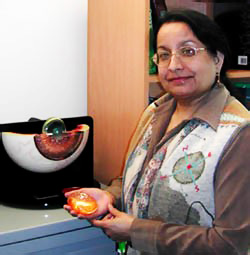UAlbany Chemist Eyes the Role of Proteins Behind Cataracts
 |
UAlbany chemist Jayanti Pande's work has been funded for 15 years by the National Eye Institute. |
Cataracts occur when proteins in the lens of the eye clump together and obstruct the passage of light. Although they generally occur in older people, cataracts also arise from genetic mutations in young people.
Jayanti Pande, an associate professor in the Department of Chemistry, works on understanding the mechanism by which different types of cataracts form. She says that detailed knowledge of the biochemistry of lens proteins is necessary to develop effective treatments.
What Causes Cataracts: the Aberrant Protein
Pande's research essentially compares the chemistry of common protein mutants -- several dozen are known -- to their normal counterparts. Even tiny changes in a protein's makeup can change its behavior in the lens. "Many times they look very similar," she says of the mutated proteins' three-dimensional structures. "But there's a dramatic change in solubility."
For normal function, the proteins should remain dissolved in the lens cells. Problems start when proteins crystallize, or separate out of solution. That's when they clump and scatter light away from the retina. But the chemical reason for protein aggregation in the lens has not been well described.
"The conventional thinking about proteins that clump -- whether in the lens or other organs -- is that the protein literally unravels," Pande says. This is true in some cases, but not all. "We were one of the first to show that you don�t have to have the protein unravel or unfold for clumping to occur."
Her research is at the most fundamental level, but Pande hopes it will enable the development of useful therapeutics for cataracts. The National Eye Institute, which has funded her work for 15 years, awarded Pande a five-year $1.6 million grant to continue to build her "mechanism library" of all the different types of cataracts. She also will test compounds that might bind to aberrant eye proteins and alter their solubility to normal values.
Pande's work also has been an inspiration to her students at UAlbany. Among them was Juliet Patrosz '10, who, under Pande's mentorship, won the prestigious Barry M. Goldwater Scholarship in 2008.
![]() For more news, subscribe to UAlbany's RSS headline feeds
For more news, subscribe to UAlbany's RSS headline feeds


